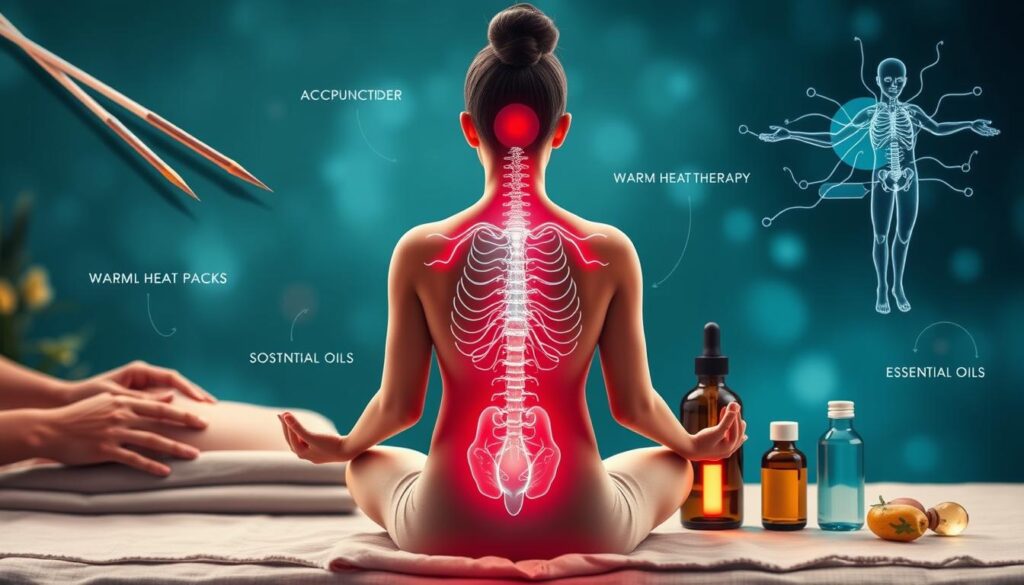Chronic pain is a complex issue that can greatly affect your daily life. The Mayo Clinic Guide to Pain Relief and the Painless Center, led by Dr. Jason Chiu, provide valuable insights. They explain chronic pain, its causes, and the many treatment options available.
Chronic pain lasts more than three months and is common in the U.S. To manage it well, you need to understand how the brain handles pain and the impact of your thoughts and actions. By using a variety of approaches, you can find relief and improve your life.
Key Takeaways
- Chronic pain is a complex condition that can significantly impact daily life and quality of life.
- Effective chronic pain management requires a comprehensive understanding of the underlying mechanisms, including the brain’s role in pain perception and the influence of behaviors and beliefs.
- The Painless Center, led by Dr. Jason Chiu, provides a multidisciplinary approach to chronic pain management, offering a wide range of treatment options.
- Treatment approaches for chronic pain may include medications, interventional procedures, advanced treatment technologies, and non-pharmacological strategies.
- Integrating physical and mental wellness techniques, such as exercise and cognitive-behavioral therapy, can enhance the effectiveness of chronic pain management.
Understanding the Complex Nature of Chronic Pain
Chronic pain is more than just physical discomfort. It involves the brain’s role in pain perception. Behaviors and beliefs also play a big part in how we feel pain. Conditions like fibromyalgia, lower back pain, and nerve pain can come from injuries, illnesses, or nerve damage.
The Brain’s Role in Pain Perception
The brain controls how we feel pain. It decides how intense, long-lasting, and emotional pain is. Stress, anxiety, and mood can change how we perceive pain, showing the link between physical and mental aspects of chronic pain.
How Behaviors and Beliefs Impact Pain Experience
Our actions and thoughts greatly affect chronic pain. Negative thoughts, avoiding activities, and bad coping strategies can make pain worse. On the other hand, positive thinking, being active in pain management, and healthy habits can lessen pain’s impact.
Common Types of Chronic Pain Conditions
- Fibromyalgia: A chronic condition with widespread pain, fatigue, and sleep issues.
- Lower Back Pain: Often caused by injury, poor posture, or other conditions, it limits activity.
- Neuropathic Pain: Damage to the nervous system causes burning, tingling, or shooting pain.
- Osteoarthritis: A degenerative joint disease leading to pain, stiffness, and mobility loss.
- Cancer Pain: Common in advanced stages, needing a comprehensive management approach.
- Headaches: Including migraines, cluster headaches, and tension headaches, affecting many adults.
Understanding the complex factors of chronic pain is key to managing it. By knowing the physical, psychological, and social aspects, healthcare can create personalized plans. This helps meet each patient’s unique needs.
Comprehensive Diagnosis and Assessment Methods
Managing chronic pain starts with a detailed diagnosis and assessment. This includes a thorough physical check-up, looking at your medical history, and sometimes tests like X-rays or MRIs. These steps help doctors find the root cause of your pain, which is key to creating a good treatment plan.
Pain assessment tools are important for understanding how much pain you’re in. The Numeric Rating Scale (NRS) is often used because it’s simple and quick. Patients rate their pain from 0 (no pain) to 10 (the worst pain). For those who can’t speak much, the Faces Pain Scale uses pictures to help.
Doctors also look at how pain affects your daily life and overall well-being. Tools like the Brief Pain Inventory (BPI) ask about your worst, least, and average pain. This helps doctors see the full picture of your pain and plan better treatments.
Getting a correct diagnosis and doing a full assessment is key for good Pain Management Techniques and Non-Pharmacological Treatments. By looking at your physical, emotional, and functional status, doctors can make a treatment plan that fits you best.

“Effective chronic pain treatment requires a comprehensive assessment that considers biomedical, psychosocial, and behavioral factors.”
Chronic Pain Management: Medical Treatment Approaches
Managing chronic pain relief often needs a mix of treatments. This includes medicines, interventional procedures, and new technologies. Doctors aim to find the best management techniques for each patient.
Prescription and Over-the-Counter Medications
For chronic pain, people often use NSAIDs and acetaminophen. Prescription drugs like muscle relaxants and antidepressants are also used. But, the FDA has strengthened warning labels on NSAIDs due to potential risks.
This shows the need for careful use of medicines under a doctor’s watch.
Interventional Procedures and Nerve Blocks
Some treatments for chronic pain include epidural steroid injections and nerve blocks. These aim to stop pain signals and reduce swelling. PCA and trigger point injections are also used in pain management.
Advanced Treatment Technologies
New technologies like intrathecal drug delivery systems and spinal cord stimulation implants are emerging. They offer precise treatments for chronic pain. These might help those who haven’t found relief with other methods.
Getting pain relief and pain management right takes teamwork. Patients and doctors must work together. By knowing the treatment options, people can help create a plan that fits their needs.

Non-Pharmacological Pain Relief Strategies
Managing chronic pain requires a mix of medical treatments and non-pharmacological strategies. These non-medical treatments offer many options that can work alongside or even replace medication. They focus on using the body’s natural healing and addressing the complex nature of chronic pain.
Non-Pharmacological Treatments like physical therapy, exercise, and mind-body techniques are key in pain management. TENS and bioelectric therapy can block pain signals, helping some people. Acupuncture, nutritional supplements, massage, chiropractic manipulation, and dietary changes also offer alternatives for chronic pain.
Mindfulness-Based Interventions are becoming more popular in pain management. Relaxation, meditation, guided imagery, and biofeedback can help manage chronic pain. Keeping a pain diary can also help identify triggers and find personal pain management strategies.
- Physical Therapy: Strengthening exercises, stretching, and specialized techniques can help improve mobility, restore function, and alleviate pain.
- Regular Exercise: Low-impact activities like walking, swimming, or cycling can enhance physical fitness and release endorphins, natural pain-relieving chemicals.
- TENS and Bioelectric Therapy: These methods use electrical stimulation to interrupt or block pain signals, providing temporary relief.
- Acupuncture: This ancient Chinese practice involves the insertion of thin needles into specific points on the body, which can help manage certain types of pain.
- Nutritional Supplements: Certain supplements, such as omega-3 fatty acids, vitamin D, magnesium, and antioxidants, may help reduce inflammation and alleviate pain.
- Massage Therapy: Massage can help relax muscles, improve circulation, and reduce stress, contributing to pain management.
- Chiropractic Manipulation: Adjustments and spinal manipulation performed by a chiropractor can help address musculoskeletal issues and ease pain.
- Dietary Approaches: Incorporating anti-inflammatory foods and following a Mediterranean or hypocaloric diet may help manage chronic pain.
- Relaxation Techniques: Practices like deep breathing, meditation, and guided imagery can help reduce muscle tension, stress, and pain perception.
- Biofeedback: This technique teaches individuals to control their physiological responses, such as muscle tension and heart rate, to alleviate pain.
Exploring and using these non-pharmacological strategies can help individuals with chronic pain manage their condition better. This can reduce their need for medication and improve their quality of life.
“Integrating non-pharmacological approaches into chronic pain management can empower individuals to take control of their well-being and find sustainable relief.”
Integrating Physical and Mental Wellness Techniques
Managing chronic pain well needs a mix of physical and mental health methods. Exercise is key for muscle strength and flexibility. It also releases endorphins, which help reduce pain. Psychological treatments like Cognitive Behavioral Therapy (CBT) help deal with pain’s emotional side.
The Painless Center stresses the value of lifestyle changes. These include managing stress, getting enough sleep, and eating well. Visualization and mindfulness can also help lessen pain and boost life quality for those with chronic pain.
Combining physical therapy, Cognitive Behavioral Therapy, and other pain coping strategies helps manage chronic pain. This approach tackles the physical, emotional, and psychological aspects of pain. It empowers individuals to take control of their pain and improve their future outlook.















Augustine Gucwa
Fantastic job covering this topic in such depth! Excellent post with lots of actionable advice! Thank you for breaking down complex concepts so clearly. This blog stands out among others in this niche. This article is a treasure trove of information! The examples provided make it easy to understand. Your writing style makes this topic very engaging. I’m definitely going to share this with my friends. This article is a treasure trove of information! This article is a treasure trove of information!